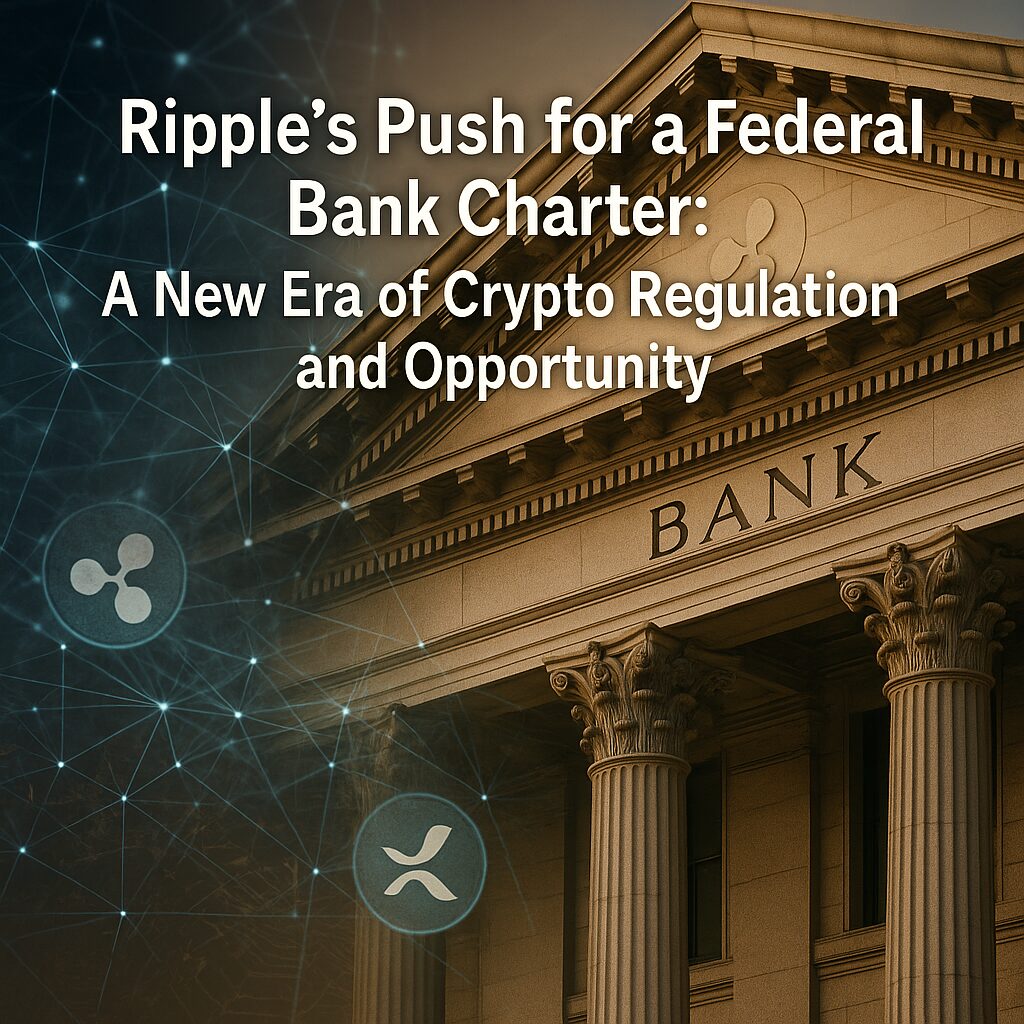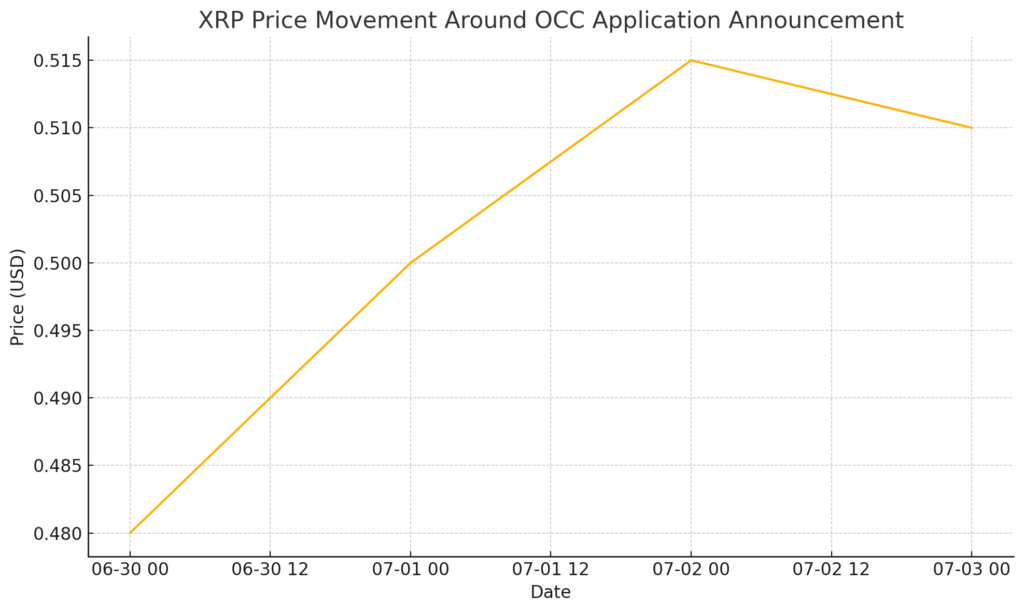
Main Points:
- Ripple has applied for a national bank charter from the U.S. Office of the Comptroller of the Currency (OCC), aiming to expand its crypto services under federal regulation.
- XRP price rose roughly 3% on the news, reflecting market optimism about regulatory clarity.
- If approved, Ripple would operate across state lines and potentially access a Federal Reserve master account for on-balance-sheet reserve management.
- The move follows similar charters sought by Circle (USDC issuer) and Anchorage Digital, signaling a trend among crypto firms to seek federal oversight.
- U.S. stablecoin legislation is advancing in Congress, making federal licensing more appealing for market participants.
- Analysis of potential benefits: enhanced credibility, operational efficiency, and a higher trust standard for RLUSD stablecoin.
- Broader industry context: traditional banks eyeing crypto, institutional adoption, and regulatory convergence.
Introduction
Ripple’s recent filing for a national bank charter with the OCC marks a significant step in the convergence of traditional finance and digital assets. This initiative, reported by the Wall Street Journal on July 3, 2025, comes amid a wave of stablecoin issuers seeking federal charters to gain unified oversight and operational advantages . For crypto investors and blockchain practitioners, Ripple’s move signals both evolving regulatory landscapes and fresh opportunities for blockchain-enabled finance.
Ripple’s OCC Charter Application
On July 2, 2025, Ripple formally applied to the OCC for a national bank charter . This charter, if granted, would permit Ripple to:
- Expand its crypto-asset services under a single federal regulator.
- Operate seamlessly across U.S. state lines without needing multiple state licenses.
- Access a Federal Reserve master account, enabling direct on-balance-sheet management of reserve assets.
Ripple’s CEO Brad Garlinghouse highlighted that such approval would establish “a new and unique standard of trust” for stablecoin markets, combining state-level oversight (via NYDFS) with federal supervision to bolster market confidence .
XRP Market Reaction
The announcement triggered an approximate 3% increase in XRP’s market value, lifting the price from around $0.50 to $0.515 on July 2, 2025. Below is a chart showing XRP price movements around the announcement:
See chart below for details.

Stablecoin and Crypto Custody Trend
Ripple’s application follows Circle’s OCC charter filing earlier this week and Anchorage Digital’s existing federal approval. These developments indicate a broader shift:
- Stablecoin Issuers Seeking Federal Oversight
- Circle’s USDC charter application underscores the appeal of a clear regulatory framework.
- Crypto Custody Firms Pursuing Credible Custody Standards
- Anchorage Digital and Custodia Bank (led by Caitlin Long) illustrate demand for secure, regulated custody solutions.
This trend aligns with the U.S. House of Representatives debating the Senate’s stablecoin legislation, which seeks to formalize stablecoin governance and reserve requirements .
Operational Advantages of a Federal Charter
A national bank charter affords Ripple several tangible benefits:
- Unified Regulatory Framework: Federal oversight simplifies compliance by reducing the need for multiple state licenses.
- Master Account Access: Direct Federal Reserve master account access allows Ripple to hold reserve assets, like U.S. Treasuries, on its balance sheet, enhancing liquidity management.
- Enhanced Credibility: Dual supervision (NYDFS + OCC) offers a more robust trust signal to institutional partners and enterprises.
Impact on RLUSD Stablecoin
Ripple issues RLUSD, a stablecoin with a market cap of $440 million (¥63.36 billion at ¥144/USD). A federal charter could:
- Improve reserve transparency through regulated reporting standards.
- Ensure higher security of collateral assets via Fed custody.
- Potentially increase institutional adoption, as banks may prefer federally chartered partners.
Regulatory Landscape and Congressional Action
The U.S. stablecoin legislative process is advancing. The Senate’s stablecoin bill proposes clear definitions, capital requirements, and reserve audits. The House is currently reviewing these measures, aiming to provide nationwide regulatory certainty .
Key legislative considerations include:
- Reserve ratio requirements (e.g., 1:1 asset backing).
- Regular third-party attestations.
- Consumer protection measures and redemption guarantees.
Broader Industry Implications
Ripple’s bid reflects the wider institutional embrace of crypto and blockchain:
- Traditional Banks Exploring Crypto: Several major banks are piloting custody and settlement services for digital assets.
- FinTech Integration: Blockchain’s transparency and speed align with fintech’s drive for efficient payments.
- Cross-Border Payments: Ripple’s XRP Ledger offers near-instant settlement capabilities, appealing to remittance markets.
Conclusion
Ripple’s OCC charter application represents a watershed moment in crypto regulation. By seeking federal oversight, Ripple not only aims to streamline its operations and bolster RLUSD’s credibility but also sets a precedent for other crypto firms. As U.S. stablecoin legislation progresses, federally chartered crypto institutions could become the new standard, bridging the gap between digital finance innovation and regulatory assurance. For crypto investors and blockchain practitioners, these developments underscore the importance of monitoring regulatory shifts, evaluating chartered entities’ stability, and exploring emerging blockchain use cases in payments and custody.

